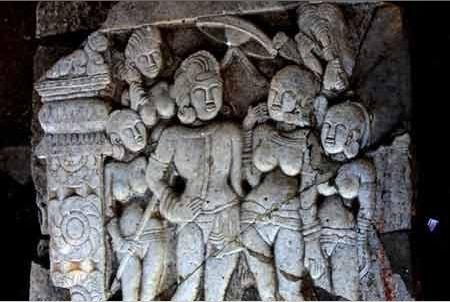Rediscovering Ashoka
Vithal C Nadkarni
Source - http://articles.timesofindia.indiatimes.com/2012-01-09/spiritual-destinations/30606797_1_emperor-ashoka-neem-tree-ancient-temple

Vithal C Nadkarni rediscovers the perennial relevance of the Ashokan credo of ahimsa and peace in Kanaganahalli.
Emperor Ashoka has stolen the show at the seminar on 'Future of the Past' in Mangalore. Participants are visibly excited when Manipal-based conservation architect Kailash Rao shows the first inscribed portrait of the Mauryan emperor ever found. This was unearthed from the ruins of a magnificent Buddhist stupa at Kanaganahalli near Gulbarga under dramatic circumstances! Imagine an ancient temple lashed by thunder and rain on a stormy night. Suddenly, the roof of the temple caves in. A giant statue of a fearsome goddess gets broken. As the pieces are removed, the base reveals a slab bearing Brahmi characters. An Archaeological Survey guard, who is among the volunteers, saves the tablet from being junked and alerts his bosses.
Treasure trove
Zoom to the code-breakers ( Shahrukh Khan, are you reading this?) who decipher Ashoka's long lost message of compassion and religious tolerance from the granite slab. It speaks of a great treasure called Adholoka Maha-Chaitya, the Great Stupa of Nether or the Southern World.
Cut to the dig, barely half a kilometre away from the temple, where archaeologists are racing against time to save the ruins of a spectacular Stupa from the rising waters of a newly built barrage on the Bhima River.
Now, a close-up of a limestone panel lying under a neem tree; it shows up Brahmi letters which simply say 'Rayo Ashoka', in Prakrit! From below the letters, emerges the exquisitely turbaned visage of one of the world's greatest emperors, surrounded by female attendants and his beautiful queens.
Ashoka has regained his face at last, in the 21st century. A few weeks later, when we visit Kanaganahalli, we find the portrait of yet another king beneath that of Ashoka under a parasol. This one has a great Satvahana king tugging off a necklace; a graphic evidence of Buddhism's proclaimed disdain for worldly wealth.
This comes across in the very first sentences of Ashoka's refurbished edict, which is prominently displayed today at the archeological site at Kanaganahalli: 'King Priyadarsi, the beloved of gods, respects equally the followers of other religions by offering worship and gifts,' the edict proclaims. 'But he does not accept them himself with the desire that the essence of each religion be increased among its followers.'
According to Nobel laureate Amartya Sen, this testifies Ashoka's transformation "from a tough tyrant in the traditional mould into a ceaseless advocate of kindness and benevolence and into a public promoter of the social good. "This was not only a decisive moment in Indian history, it was also accompanied by Ashoka's reasoned reflections that were momentous at his time and remain very relevant to the problem-ridden world of today," says Sen.
Sen paid this tribute to Ashoka in the preface of Bruce Rich's ambitiously titled book, Upholding the World: The Message of Ashoka and Kautilya for the 21st Century. Rich travelled to Orissa in 1991 and gazed upon the rock edicts erected by the emperor at Dhauli over 2,200 years ago. Intrigued by the stone inscriptions that declared religious tolerance, conservation, nonviolence, protection of all species, and human rights, Rich was struck by their timeless relevance.
"Ashoka provides a unique example of a world ruler," Rich writes. "His empire at the time was arguably the world's largest, richest and the most powerful multi-ethnic state. He tried to put into practice a secular state ethic of nonviolence and reverence for life, which he also extended to international relations."
Where's the Buddha?
Similar sentiments are echoed by Daisaku Ikeda, Buddhist philosopher, educator and peace-builder: "Whenever I consider the psychic landscape of humanity (in this century), the image of Ashoka the Great, India's outstanding ancient sovereign comes inevitably to my mind."
Ikeda says modern humanism tends to emphasise dualism and conflict. This produces discrimination and rejection of others. One way of overcoming such schisms and divides is to embrace inclusive cosmologies as promoted by Ashoka's reign. "The dharma-based humanism that supported the emperor's reign is an excellent example of inclusion," he adds. "It is succinctly expressed in the two fundamental principles of Ashoka's rule: nonkilling and mutual respect."
Our excitement over finding Ashoka's likeness is tempered by the realisation that the Buddha himself is conspicuously absent from the carvings of Kanaganahalli. Instead, there are boldly carved empty seats shown on the limestone panels along with footprints. "This was a revolutionary concept way ahead of its times," says physicist Mayank Vahia. He organised the 'Future of the Past' meeting for the Tata Institute's Bangalore-based International Centre for Theoretical Studies.
"The Buddha himself proclaimed that the institution, the Sangha or the Dhamma, was bigger than the individual. This continues to remain extremely relevant for our own uneasy times."
To the informed layman, therefore, the emptiness of space that the Satvahana artists portrayed seems to pulsate with the Buddha's spiritual and moral authority.
Creative emptiness
However, Buddhist philosophers say emptiness (sunyata) must not be confused with nothingness. Emptiness is not nonexistence and it is not nonreality. "We can compare this Buddhist notion of creative emptiness to the thoroughly modern concept that physicists have of 'emptiness' of vacuum," Mayank Vahia elaborates. "They say, what we think of as a vacuum may not be empty at all. That emptiness is a veritable atomic cauldron seething with real and virtual particles and anti-counterparts spontaneously popping in and out of existence!" he says.
As we leave Kanaganahalli, the celebrated line from the Prajna Paramita Hridaya Sutra, commonly known as the Heart Sutra, comes to our mind: "Form is emptiness; emptiness is form."